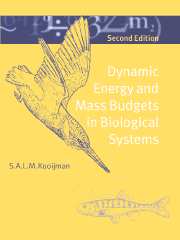Book contents
- Frontmatter
- Contents
- Preface to the second edition
- Preface
- Book organization
- Acknowledgements
- 1 Energetics and models
- 2 Basic concepts
- 3 Energy acquisition and use
- 4 Uptake and use of essential compounds
- 5 Multivariate DEB models
- 6 Uptake and effects of non-essential compounds
- 7 Case studies
- 8 Comparison of species
- 9 Living together
- 10 Evaluation
- Bibliography
- Glossary
- Notation and symbols
- Taxonomic index
- Subject index
Preface to the second edition
Published online by Cambridge University Press: 12 March 2010
- Frontmatter
- Contents
- Preface to the second edition
- Preface
- Book organization
- Acknowledgements
- 1 Energetics and models
- 2 Basic concepts
- 3 Energy acquisition and use
- 4 Uptake and use of essential compounds
- 5 Multivariate DEB models
- 6 Uptake and effects of non-essential compounds
- 7 Case studies
- 8 Comparison of species
- 9 Living together
- 10 Evaluation
- Bibliography
- Glossary
- Notation and symbols
- Taxonomic index
- Subject index
Summary
The substantial progress made in many developments of the Dynamic Energy Budget (DEB) theory and its applications has prompted a new edition of the book ‘Dynamic Energy Budgets in Biological systems – Theory and Applications in Ecotoxicology’ I must admit that, while extending the theory, I did not exclude the risk that the theory would tumble over, like an overloaded Christmas tree. However, the opposite has happened; the theory has gained in logical structure, broadened its physico-chemical basis, and become in many respects simpler conceptually. I consider this to be the most reliable indication that the theory really has a strong and healthy backbone.
The most fundamental progress is in the development of a framework that accommodates both energy and mass fluxes. This provides a theoretical basis for the method of indirect calorimetry and elaboration of the coupling between energy and mass fluxes, including respiration rates. Simultaneous limitation of growth by nutrients is modelled by the construct ‘Synthesizing Unit’, which is a ‘natural’ generalization of single substrate enzyme kinetics, after re-formulation in terms of substrate fluxes rather than substrate concentrations. Extending the theory from one reserves and structural mass to several provides the proper conceptual basis to deal with autotrophs (algae, plants). These had to be omitted in the first edition. Hence, the title has be changed slightly, because now the theory covers all forms of life.
The DEB theory has been deepened as well as extended. The assumption of first-order dynamics for reserve density has been replaced by more fundamental ones about body composition. Although this change has no quantitative consequences, the conceptual gain is considerable for a theory that emphasizes mechanisms and consistency.
Information
- Type
- Chapter
- Information
- Dynamic Energy and Mass Budgets in Biological Systems , pp. xi - xiiPublisher: Cambridge University PressPrint publication year: 2000
